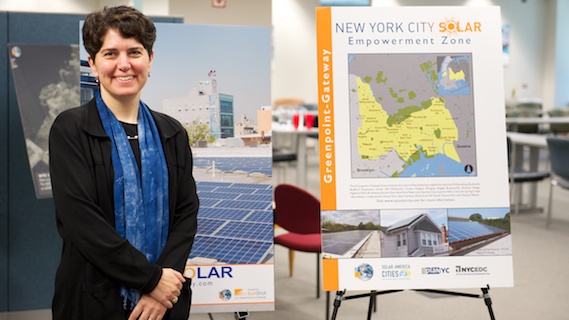
Tria Case, University Director of Sustainability for The City University of New York, was the plenary speaker in BMCC’s recent conference, Sustainability and Technology: New Directions in Teaching and Learning.
BMCC Associate Dean of Academic Affairs Michael Gillespie welcomed participants to the conference, quoting Albert Einstein’s still-timely observation, “If we do not harness technology, technology will harness us.”
For CUNY and BMCC students, harnessing the technology for sustainability, or building a career in the field, starts with choosing a related major.
“Understanding GIS [Geographic Information Science], simple programming and IT skills, are all part of being in this field,” Case explained, as she talked with participants before her address. “Or, if you want to impact policy, you need to understand analytics.”
At the undergraduate level, she said, students might get involved in the Cleantech Scholars program, which is supported by Con Edison and gives CUNY students majoring in STEM (Science, Technology, Engineering, and Math) disciplines the opportunity for a ‘Real World’ supplement to their education through projects within the NYCleantech Mentors Network.
The sustainability field is highly interdisciplinary, and she gave the example of the CUNY sustainability team, which includes solar ombudsmen, “some of whom have both engineering and energy policy backgrounds.”
Another route a person interested in sustainability studies might take, she said, is building management.
“There is the building performance lab at City College. Graduates earn a Master of Science in Sustainability in the Urban Environment, through a program that is jointly run by the architecture and engineering departments.”
Or if they’re interested in the business side of sustainability, “a student could consider the Sustainable Business graduate program Baruch College,” she said. “Another option is the CUNY BA program in urban planning at Hunter College.”
Solar energy, citywide
A business major focused on sustainability issues might end up on a team like the one at CUNY that manages the university’s energy budget, and creates incentives for campuses to improve their energy efficiency.
“Each campus has an energy budget,” says Case, “and so far each campus has come in under their allocated budget, and that savings goes back to them.”
CUNY accounts for one percent of the City’s energy usage, and “what we do can truly make a difference across the City,” said Case. She outlined the CUNY Sustainability Project, which focuses on curriculum development, procurement of goods, water use, transportation and in creating a 10-year sustainability plan.
CUNY has also created Solar Empowerment Zones throughout the City, and she discussed challenges including the vertical nature of an urban environment, which skews the ratio of roof-to-surface space, and the cooling effect of shadows that over a million buildings in close proximity throw on each other.
Despite these challenges, the City has gone from one megawatt of solar energy in action in 2006, to 14 megawatts in 2013.
Mapping out a solar plan
To raise the City of New York’s solar usage, CUNY initially responded to a call for proposals from the Mayor’s Office, and has since created a road map for the marketplace on developing solar power.
The CUNY Sustainability team has brought together policy makers, utility company representatives, engineers, IT experts and others, and has created the first NYC Solar Map.
“If you plug in any address, Google maps will take you to that location and information about that energy system will pop up,” explains Case. “It answers the questions, ‘How much would solar installation cost at that site?’ and ‘How much would I save, taking into consideration local data, cost, and other factors specific to that location?’”
Students at Hunter College and other CUNY campuses helped develop this three-dimensional map, which Case describes as “the most granulated solar map in the world.”
BMCC faculty and staff share innovative strategies
In addition to the morning’s plenary address, the Sustainability and Technology conference provided a demofest showcasing technologies for the classroom, and in breakout sessions, faculty and staff shared innovative strategies for using technology to enhance student learning.
Demofest abstracts included Yan Chen’s presentation about a free web-based video conference platform, Google Hangouts, while Colin Persaud shared information on the ease of scheduling courses in the automated system, Access. Ruru Rusmin was on hand to talk about the advantages of BlackBoard Collaborative, a real-time web conferencing environment, and Chiaki Yanagisawa and Elisa Pigeron discussed the Smart pen, which records students’ writing and transfers it to their computer. Frank Crocco and Jo Bisz shared information about College Quest, a platform for hybrid and e-learning.
Five Minutes of Fame abstracts included a presentation by Cynthia Wiseman, who talked about using SurveyMonkey as a tool for formative assessment in the classroom. Shoba Bandi-Rao discussed using mobile technology with ESL learners.
Breakout sessions included a talk about using Skype to bring speakers to the classroom, by Elizabeth Berlinger, and an overview by Rosalie Gleicher and Janey Flanagan on online learning. Geoff Klock discussed the creation of a 14-minute YouTube mash-up of 4-second clips from movies and shows that discuss or perform Hamlet, and Christina Lev gave information on CUNYfirst, the university’s new information data system. Al Leibman discussed Cause in a Classroom, a non-profit learning management system that combines educational and humanitarian values in the classroom, and Joshua Belknap presented on the ESL Lab Wiki.
At the close of the day, Developmental Skills professor Cynthia Wiseman moderated a panel, “Sustainability across the curriculum: Can technology help us get there?”
The conference was organized with the cooperation of the Office of Academic Affairs, CETLS, the Media Center, the E-Learning Center, the College Computing Center, and the Office of Instructional Technology.

